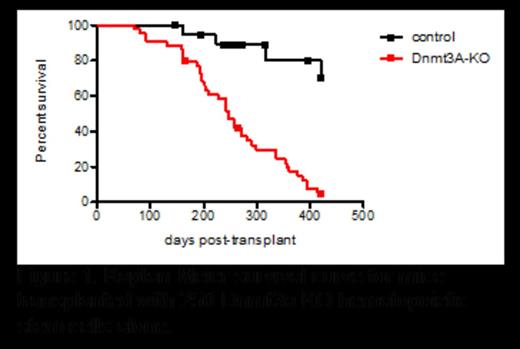Bone marrow failure (BMF), the inability to regenerate the differentiated cells of the blood, has a number of genetic and environmental etiologies, such as mutation of telomere-associated protein genes and immune-related aplastic anemia. Recently, mutations in DNA methyltransferase 3A (DNMT3A) have been found to be associated with approximately 15% of cases of primary myelofibrosis (MF), which can be a cause of BMF. The role of DNMT3A more broadly in hematopoiesis, and specifically in BMF, is currently poorly understood. DNMT3A is one of two de novo DNA methylation enzymes important in developmental fate choice. We showed that Dnmt3a is critical for normal murine hematopoiesis, as hematopoietic stem cells (HSCs) from Dnmt3a knockout (KO) mice displayed greatly diminished differentiation potential while their self-renewal ability was markedly increased1, in effect, leading to failure of blood regeneration or BMF. Combined with loss of Dnmt3b, HSCs exhibited a profound differentiation block, mediated in part by an increase of stabilized b-catenin. While we did not initially observe bone marrow pathology or malignancy development in mice transplanted with Dnmt3a KO HSCs, when we aged a large cohort of mice, all mice succumbed to hematologic disease within about 400 days. Roughly one-third of mice developed frank leukemia (acute lymphocytic leukemia or acute myeloid leukemia), one-third developed MDS, and the remainder developed primary myelofibrosis or chronic myelomonocytic leukemia. The pathological characteristics of the mice broadly mirror those of patients, suggesting the Dnmt3a KO mice can serve as a model for human DNMT3A-mutation associated disease. Strikingly, bone marrow of mice with different disease types exhibit distinct DNA methylation features. These will findings and the implications for disease development will be discussed. We are currently investigating the factors that drive different outcomes in the mice, including stressors such as exposure to interferons. We have hypothesized that HSC proliferation accelerates the Dnnmt3a-associated disease phenotypes. We have previously shown that interferons directly impinge on HSCs in the context of infections. Interferons activate HSCs to divide, generating differentiated progeny and cycling HSCs. Repeated interferon stimulation may permanently impair HSC function and bias stem cell output. When combined with loss of Dnmt3a, interferons may promote BMF. We will discuss broadly how external factors such as aging and infection may collaborate with specific genetic determinants to affect long-term hematopoiesis and malignancy development.
Reference:
Challen GA, Sun D, Jeong M, et al. Dnmt3a is essential for hematopoietic stem cell differentiation. Nat Genet 2012; 44: 23-31
No relevant conflicts of interest to declare.
Author notes
Asterisk with author names denotes non-ASH members.


This feature is available to Subscribers Only
Sign In or Create an Account Close Modal